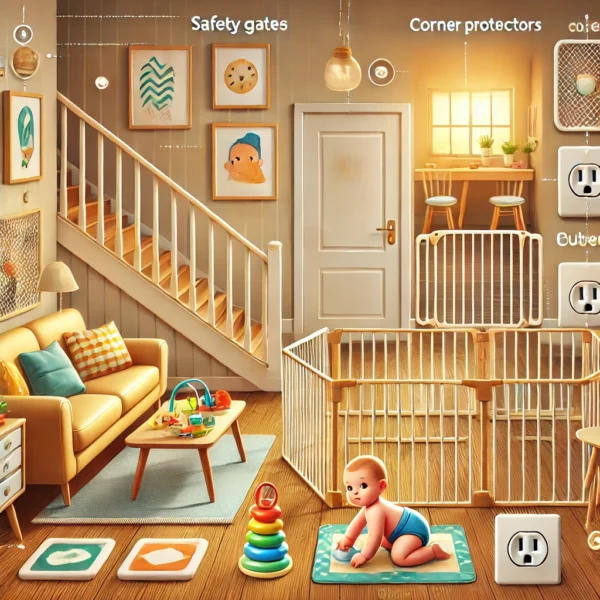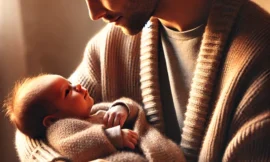Essential Baby-Proofing Tips for a Safe and Secure Home

Baby-proofing your home is essential for keeping your child safe as they begin to explore their surroundings. Babies are naturally curious, and their mobility increases as they start to crawl and walk, which makes baby-proofing a critical part of baby care. Here are some comprehensive tips to help you baby-proof your home:
1. Secure Furniture
Babies love to pull themselves up on furniture, so ensure that heavy furniture like dressers, bookshelves, and televisions are securely anchored to the wall to prevent tipping. Use anti-tip brackets or wall straps for extra safety. Avoid placing items like toys on top of furniture, which might encourage climbing.
2. Install Baby Gates
To prevent falls and restrict access to certain areas of the house:
- Use baby gates at the top and bottom of stairs.
- Place gates at the entrances of rooms that aren’t baby-safe, like the kitchen or bathroom.
- Opt for hardware-mounted gates at the top of stairs for a more secure fit.
3. Cover Electrical Outlets
Curious little fingers may be tempted to poke into electrical outlets, so install outlet covers or plates that automatically slide closed when the outlet is not in use. These provide a simple, effective barrier to prevent shocks.
4. Protect Against Sharp Corners
Install corner guards or edge bumpers on furniture and countertops with sharp corners to reduce the risk of injury when babies crawl or toddle around.
5. Secure Cords and Blinds
- Blind Cords: Loose blind or curtain cords can be a strangulation hazard. Tie them up high or install cord winders to keep them out of reach.
- Electrical Cords: Bundle and hide electrical cords using cord organizers or covers. Keep cords from lamps and appliances out of the baby’s reach.
6. Install Cabinet Locks
Use safety latches or locks on cabinets and drawers, especially those containing harmful items like cleaning supplies, sharp utensils, or medications. Magnetic locks or adhesive latches work well for keeping babies out while allowing easy access for adults.
7. Keep Hazardous Items Out of Reach
- Medications and Cleaning Supplies: Store all medications, household cleaners, and chemicals in high cabinets or locked storage units to avoid accidental poisoning.
- Choking Hazards: Keep small objects (coins, batteries, small toys) out of reach to prevent choking. Anything that can fit through a toilet paper roll is a potential choking hazard.
8. Lock Toilets
Babies are fascinated by toilets, but they pose a drowning risk. Install toilet locks to keep the lid securely closed and ensure bathroom doors are kept shut.
9. Install Stove and Oven Guards
- Knob Covers: Install stove knob covers to prevent babies from turning on the burners.
- Stove Guards: Place stove guards to block access to hot pots and pans. Always turn pot handles inward so they can’t be grabbed from the edge.
10. Use Door Stoppers
To avoid pinched fingers, install door stoppers or pinch guards on doors. These will stop doors from slamming shut, preventing injuries.
11. Check Windows
Windows pose a risk of falls. Ensure that window locks or safety latches are in place to prevent babies from opening them. Consider installing window guards, especially in rooms above the first floor. Also, keep cribs and other furniture away from windows to prevent climbing.
12. Baby-Proof the Crib
Ensure that your baby’s crib meets safety standards:
- Remove any pillows, blankets, or stuffed animals to reduce the risk of suffocation.
- The mattress should fit snugly with no gaps between it and the crib frame.
- The crib slats should be no more than 2 3/8 inches apart to prevent the baby from getting stuck.
- Make sure the crib is positioned away from any cords, windows, or shelves.
13. Bathtub Safety
Never leave a baby unattended in the bathtub, even for a moment. Use non-slip mats in the tub and on the bathroom floor to prevent slips. Install a faucet cover to protect your baby from bumps and burns, and set your water heater to 120°F (49°C) to avoid accidental scalding.
14. Secure Heavy Appliances
Ensure that heavy appliances like microwaves, dishwashers, and refrigerators are stable and out of reach. Babies can pull on handles and open doors, so secure appliances with safety latches or lock systems where necessary.
15. Keep Plants Out of Reach
Some houseplants can be toxic if ingested, so place plants out of reach or consider removing them from the home entirely. Be mindful of leaves or dirt that may fall to the floor and become accessible to a crawling baby.
16. Maintain Smoke and Carbon Monoxide Detectors
Make sure you have working smoke detectors and carbon monoxide alarms installed on every floor of your home, especially near bedrooms. Test them regularly and replace batteries as needed.
17. Baby-Proofing the Living Room
- Fireplace: If you have a fireplace, install a sturdy gate or barrier around it. Keep matches, lighters, and fire-starting materials out of sight and reach.
- TV and Entertainment Centers: Mount your TV on the wall or use safety straps to secure it to prevent tipping. Organize and hide any loose cords from electronics to avoid strangulation hazards.
18. Ensure Safe Sleep Environments
Wherever your baby naps or sleeps, make sure the environment is safe:
- Avoid soft bedding, pillows, and plush toys in the sleeping area.
- Use a firm mattress with a fitted sheet, and always place the baby on their back to sleep.
19. Know First Aid and Emergency Numbers
Despite baby-proofing, accidents can still happen. It’s important to know basic infant first aid, such as how to treat cuts, burns, or choking. Keep a first-aid kit in your home, and make sure emergency numbers (like poison control) are easily accessible.
20. Constant Supervision
Even with thorough baby-proofing, close supervision is key to preventing accidents. As your baby grows and becomes more mobile, they’ll find new ways to explore. Keep an eye on them at all times, especially in potentially dangerous areas.
Baby-proofing your home ensures that your little one can safely explore their world while minimizing the risk of injury. Regularly inspect your home for new hazards, especially as your baby grows and becomes more mobile, adjusting your safety measures as needed.


